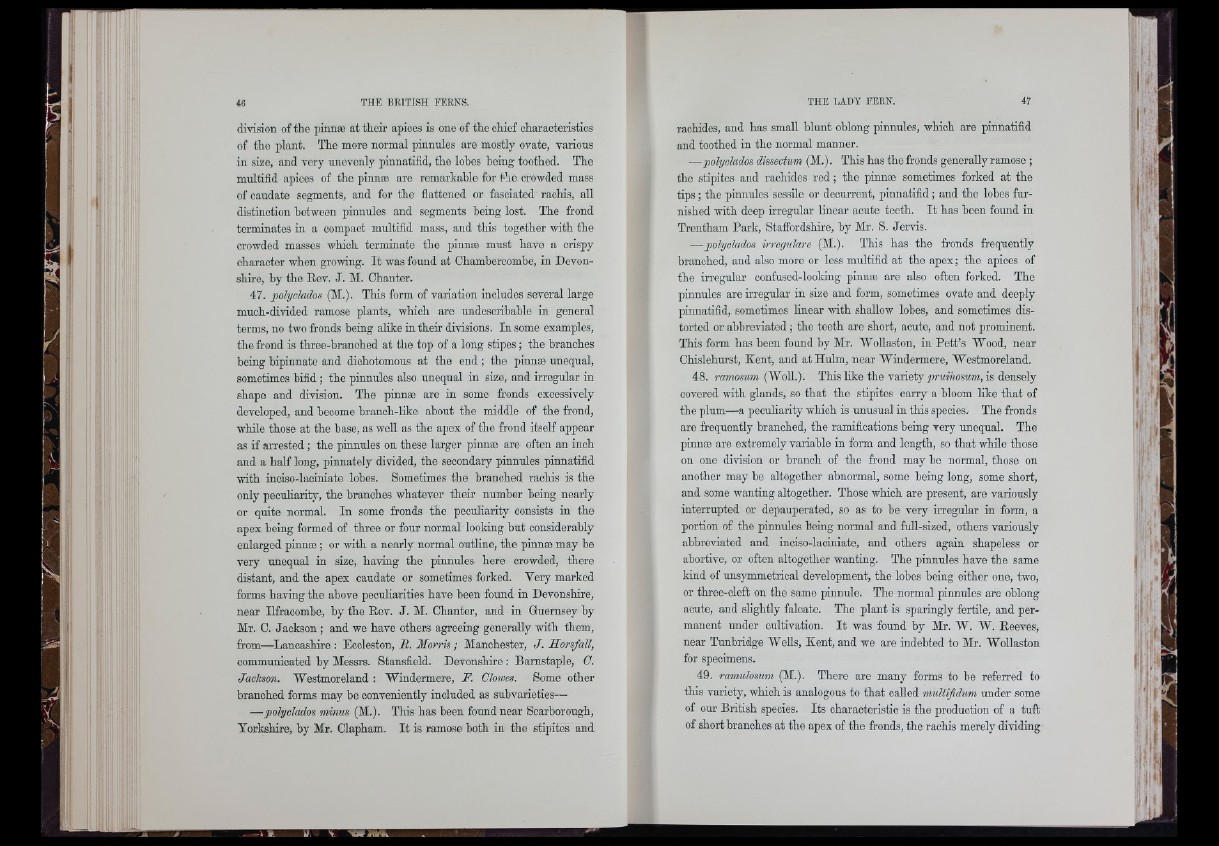
division of the pinnæ at their apices is one of the chief characteristics
of the plant. The more normal pinnules are mostly ovate, various
in size, and very unevenly pinnatifid, the lobes being toothed. The
multifid apices of the pinnæ are remarkable for the crowded mass
of caudate segments, and for the flattened or fasoiated raohis, all
distinction between pinnules and segments being lost. The frond
terminates in a compact multifid mass, and this together with the
crowded masses which terminate the pinnæ must have a crispy
character when growing. It was found at Chambercombe, in Devonshire,
by the Rev. J. M. Chanter.
47. polyclados (M.). This form of variation includes several large
much-divided ramose plants, which are undesoribable in general
terms, no two fronds being alike in their divisions. In some examples,
the frond is three-branched at the top of a long stipes ; the branches
being bipinnate and diohotomous at the end ; the pinnæ unequal,
sometimes bifid ; the pinnules also unequal in size, and irregular in
shape and division. The pinnæ are in some fronds excessively
developed, and become branch-like about the middle of the frond,
while those at the base, as well as the apex of the frond itself appear
as if arrested ; the pinnules on these larger pinnæ are often an inch
and a half long, pinnately divided, the secondary pinnules pinnatifid
with inciso-laoiniate lobes. Sometimes the branched rachis is the
only peculiarity, the branches whatever their number being nearly
or quite normal. In some fronds the peculiarity consists in the
apex being formed of three or four normal looking but considerably
enlarged pinnæ ; or with a nearly normal outline, the pinnæ may be
very unequal in size, having the pinnules here crowded, there
distant, and the apex caudate or sometimes forked. Very marked
forms having the above peculiarities have been found in Devonshire,
near Ilfracombe, by the Eev. J. M. Chanter, and in Guernsey by
Mr. C. Jackson ; and we have others agreeing generally with them,
from—Lancashire : Eocleston, B. Morris ; Manchester, J. HorsfaU,
communioated by Messrs. Stansfleld. Devonshire : Barnstaple, C.
Jackson. Westmoreland ; Windermere, F. Clowes. Some other
branched forms may he conveniently included as subvarieties—•
—polyclados minus (M.). This has been found near Scarborough,
Yorkshire, by Mr. Clapham. It is ramose both in the stipites and
rachides, and has small blunt oblong pinnules, which are pinnatifid
and toothed in the normal manner.
—polyclados dissectum (M.). This has the fronds generally ramose ;
the stipites and rachides red ; the pinnæ sometimes forked at the
tips ; the pinnules sessile or deourrent, pinnatifid ; and the lobes fur-
nisbod with deep irregular linear acute teeth. It has been found in
Trentham Park, Staffordshire, by Mr. S. Jervis.
—polyclados irreguläre (M.). This has the fronds frequently
branched, and also more or less multifid at the apex; the apices of
the irregular confusod-looking pinnæ are also often forked. The
pinnules are irregular in size and form, sometimes ovate and deeply
pinnatifid, sometimes linear with shallow lobes, and sometimes distorted
or abbreviated ; the teeth are short, acute, and not prominent.
This form has been found by Mr. Wollaston, in Pett’s Wood, near
Chislohurst, Eent, and atHulm, near Windermere, Westmoreland.
48. ramosum (WoH.). This hke the variety y>nÄsi<m, is densely
covered with glands, so that the stipites carry a bloom hke that of
the plum—a peculiarity which is unusual in this species. The fronds
are frequently branched, the ramifications being very unequal. The
pinnæ are extremely variable in form and length, so that whüe those
on one division or branch of the frond may he normal, those on
another may be altogether abnormal, some being long, some short,
and some wanting altogether. Those which are present, are variously
interrupted or depauperated, so as to be very irregular in form, a
portion of the pinnules being normal and full-sized, others variously
abbreviated and inciso-laoiniate, and others again shapeless or
abortive, or often altogether wanting. The pinnules have the same
kind of unsymmetrioal development, the lobes being either one, two,
or three-cleft on the same pinnule. The normal pinnules are oblong
acute, and slightly falcate. The plant is sparingly fertile, and permanent
under cultivation. It was found by Mr. W. W. Eeevés,
near Tunbridge WeUs, Kent, and we are indebted to Mr. WoUaston
for specimens.
49. ramulosum (M.). There are many forms to he referred to
this variety, which is analogous to that called multifidum imder some
of our British species. Its characteristic is the production of a tuft
of short branches at the apex of the fronds, the rachis merely dividing
I. !
Pi r'li
r .
- i
J i *
■ 11